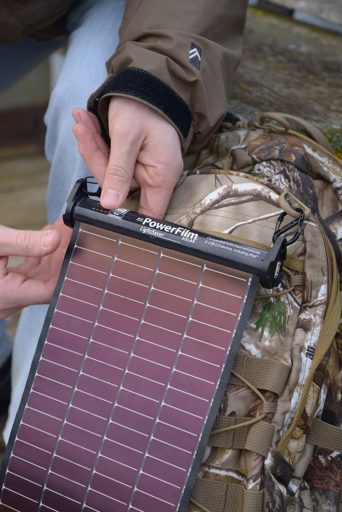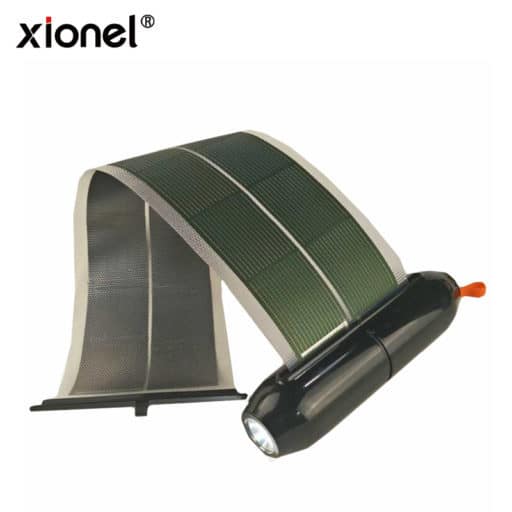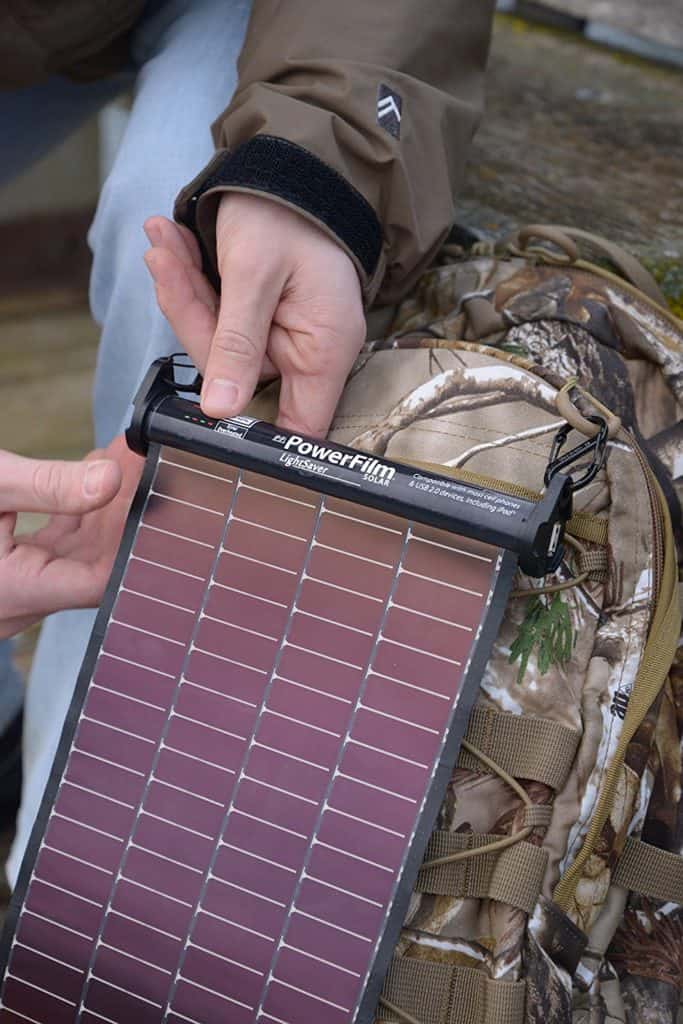I am looking to upgrade my solar charging ability. I have the Powerfilm USB + AA Charger at 1.5 watts which I have found adequate for myself. But we now have more rechargeable devices some having larg(er) wattage capacities so that I find it struggling. Ideally I think I would prefer a rollable panel which does not have its own battery backup (as I would prefer to configure this myself).
It also makes it harder to compare the performance of the various units as the ‘rate of charge’ you get on your device (eg 1% per minute on your smart phone say) is likely to be more a factor of the size and performance of the solar charger’s own internal battery than the output of the panels themselves.
For example, 5 watts should give you 1 amp (1,000 ma/h) at 5 volts (standard USB current – Watts = amps x volts). An approx 3,000 mah battery such as your phone or an 18650 battery should charge in 3-4 hours of bright sunshine therefore. There are two of us, so such a setup should charge both our phones in one day and two 18650s the next day. This is quite enough to charge other devices we might carry such as Nightcore torches, our cameras, satellite messengers and GoTennas. We usually use our phones for mapping/GPS functions.
Powerfilm Lightsaver 3 watts:

Clearly you need a flexible solar panel (such as this one) as you will want to ‘wear’ the panel on your back pack, or store it safely in your pack without fear of its breaking. You also need one which can be pegged out or tied out so it does not flap in the wind – something which will surely break small electrical wires. The voice of experience here!
https://www.amazon.com/LightSaver-USB-Roll-up-Solar-Charger/dp/B016N2NMBC & https://www.powerfilmlightsaver.com 3200mah battery 1 amp 5 volts 3 watts panel 4.9 oz (139 grams – you can probably save 10 grams by cutting off the ‘tail’). 7.8″ x 18.5″ US98.97 (April 2018) Certainly good enough for one person.
Its ‘Big Brother’ https://www.powerfilmlightsaver.com/lightsaver-max Unrolled: 34.5” x 13.5” Weight: 1.5 lbs Battery: 18,000 mAh Too big for a pack!
There do exist other stand alone rollable panels such as this one at 269 grams. It is 7 watts but is 368 x 584 (14″ x 23″) so would be a bit big to fit over your pack. Still 7 whole watts would get your devices charged pronto in the middle of the day. Unfortunately as you would not get any use out of it while walking you would have to make do with the last couple of hours of the day which would probably mean in a hiking situation you would not get much more out of it than the one pictured. I will be conducting a bit of a survey of them before I commit to buy.
I may even have to do some modification to them to get just what I want. For example cut this one down to just the panel/charger and make it charge my own 18650 batteries. It has 4.5 watts and the panel alone appears to weigh only 50 grams. 200 x 550 (8″ x 22″) would fit your pack better than many options. And 4.5 watts – much closer to what we might need as a couple.
You can buy a 5 volt output circuit with USB for less around $5. If you are up to a bit of soldering you could discard most of the mass and have a pretty handy solar panel to attach one of your 18650 chargers to eg this one or this.

NB:A word about high altitude: I took the USB + AA on my Everest Base Camp Trek. At that altitude (above 3,000 metres it failed to keep up with my phone batteries’ charging needs even though it was bright sunshine all the time! By the same token the spare charged batteries themselves were rapidly going flat even when just stored in my pack. This applied to both Eneloops and Lithiums. It was not a temperature thing as it was nowhere near as cold as it normally is camping out in the Gippsland mountains in the winter. It was clearly an altitude/pressure effect. It may be possible to store the batteries in an inflated/pressurised bag to prevent this. Worth a try.
BTW: It is very difficult to keep your phone batteries charged on this trek even though all the accommodation places offer phone charging (at around $5 a charge – compared to $1-2 for the night’s accommodation itself!) If you have a large battery (my friend had some around 10 mah) the solar systems they have in Nepal will be unable to charge them. I recommend you stick to your phone battery and maybe 1-2 of the rechargeable 18650 batteries and one of the two chargers recommended (below) for them. A hot(ish) shower also costs around $5 – far more than a meal! Watch out for the dread Khumbu Cough. I did not. Have fun.
PS: Powerfilm had a 5 watt stand alone rollable panel the R15-300 (such as I think would be about an ideal capacity). It has been replaced by a the R- 7 a 7 watt unit (269 grams 14.5” x 23”). With either of these two you would have to hang them down the back of your backpack instead of over the top of it. This would reduce the available sunlight, but it might be the best available alternative for us. You would also need a cigarette lighter to USB converter such as this.
See Also:
http://www.theultralighthiker.com/ultralight-power-bank-nitecore-chargers/
http://www.theultralighthiker.com/universal-magnetic-usb-charger/
http://www.theultralighthiker.com/powerfilm-usb-aa-solar-charger/
http://www.theultralighthiker.com/power-from-heat/
http://www.theultralighthiker.com/power-from-heat/
http://www.theultralighthiker.com/11-gram-rechargeable-head-torch/
http://www.theultralighthiker.com/charging/
http://www.theultralighthiker.com/mobile-phone-battery-life/
http://www.theultralighthiker.com/nitecore-continues-to-push-the-boundaries/
http://www.theultralighthiker.com/clear-pvc-backpack-lid-for-solar-charger/
http://www.theultralighthiker.com/gotenna/
http://www.theultralighthiker.com/the-poor-mans-satellite-phone/
http://www.theultralighthiker.com/never-get-lost-just-20/
http://www.theultralighthiker.com/ultralight-camera/


How much will it cost me to have in Nigeria 🇳🇬 Kaduna state
I do not sell anything Adamu.